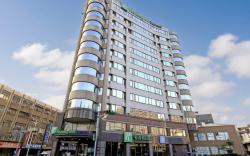Taoyuan Martyrs' Shrine and Cultural Park Introduction
Located on Huto Mountain in Taoyuan City, the Taoyuan Martyrs' Shrine was completed in the 27th year of the Republic of China and was originally built by the Japanese as the "Taoyuan Shrine." It is the best-preserved Shinto shrine from the Japanese colonial era in Taiwan. The architectural style blends ancient Chinese Tang Dynasty elements, Japanese aesthetics, and modern Taiwanese design, constructed using high-quality Taiwanese cypress wood. It was officially designated as a city historical site in the 83rd year of the Republic of China. Due to its unique historical and cultural value, it was chosen as a filming location for the movie "KANO," allowing viewers to deeply experience the memories of the 1930s. During the Japanese colonial period, Japan implemented the "Japanization" movement in Taiwan, constructing approximately 200 shrines across the island, including Taoyuan Shrine. It was built on a hillside, allowing a distant view of the Taoyuan urban area to the southwest, with a line of sight extending to the Cheng Huang Temple in the city center, symbolizing the protection of the people. Following Japan's defeat and the severing of diplomatic ties between Taiwan and Japan, many shrines faced demolition or reconstruction due to a lack of visitors, and Taoyuan Shrine was renamed the Taoyuan Martyrs' Shrine in the 39th year of the Republic of China. Its Tang-style architectural design, combined with the use of premium Taiwanese cypress wood, has been carefully maintained under the premise of preserving cultural and artistic heritage, making it the only complete shrine building outside of Japan that remains intact today. The current Taoyuan Martyrs' Shrine and Shrine Cultural Park features a complete set of buildings, including the "Main Hall," which houses personal spirit tablets, the "Worship Hall" for general worshippers, the "Shrine Office" for clergy and management, and the "Chozuya," where visitors can wash their hands and rinse their mouths before entering the shrine. Additionally, there are facilities such as torii gates, stone lanterns, Korean lion statues, bronze horse sculptures, and a pathway leading to the shrine. The construction materials used are cypress and cedar, characterized by fine textures, along with a well-preserved large wooden structural system. The beams and columns are fixed in a doweled manner, showcasing the craftsmanship and enhancing the solemn and simple beauty of the shrine cultural park. If you follow the terrain and ascend the steps beside Chenggong Road, you can see the straight pathway leading to the shrine cultural park, connecting the main gate and worship hall. This pathway continues all the way to Taoyuan Station. The park is surrounded by ancient pine and cypress trees, creating a tranquil environment. The greenery in front of the shrine is lush and nostalgic. During early spring when cherry blossoms bloom, the soft pink petals add a delicate atmosphere to the shrine park. In autumn, visitors can enjoy the beautiful red maple leaves around the garden and parking area in front of the shrine, offering different sceneries in every season. If you pause on the platform at the steps in front of the worship hall, you can overlook the entire shrine and feel the serene atmosphere surrounded by greenery, making it an ideal spot for visitors to take photos and enjoy a peaceful stroll. (Some images source: Taoyuan City Government Confucius Temple and Martyrs' Shrine Joint Management Office)





































